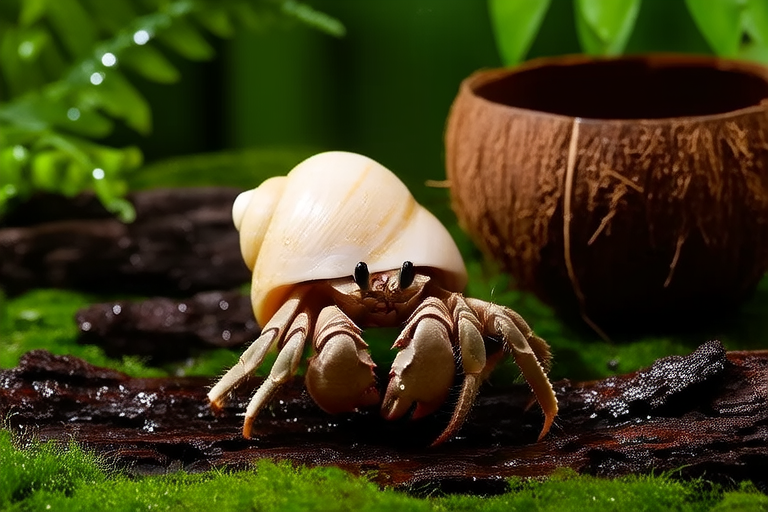How to Create the Perfect Home for Your Shy Hermit Crab
Welcome to your comprehensive guide on how to create the perfect home for your shy hermit crab. This guide will cover everything from setting up the ideal habitat to maintaining it for the well-being of your crustacean friend. Let’s dive into the essentials.
Habitat Setup
The first step in creating a comfortable environment for your hermit crab is to set up its habitat properly. The size of the tank is crucial; a ten-gallon aquarium is suitable for a small group of hermit crabs, but larger tanks are recommended as the number of crabs increases. Ensure the tank has a secure lid to prevent escapes and maintain optimal conditions inside.
Temperature and Humidity Requirements
Hermit crabs thrive in warm, humid environments. The ideal temperature range for their tank is between 75°F and 85°F (24°C to 29°C). Use a reliable thermometer to monitor these levels accurately. Maintaining a consistent humidity level between 70% and 80% is equally important. This can be achieved through regular misting with dechlorinated water or using a hygrometer to measure humidity. A combination of heat lamps and humidifiers can help achieve and maintain these conditions.
Suitable Substrate Types
Selecting the right substrate is vital for the health of your hermit crabs. Crushed coral or aragonite sand is preferred because they provide calcium, which is necessary for molting. These substrates also allow for burrowing, which is essential for hermit crabs’ natural behavior. Avoid using gravel or other hard materials that can cause injury. It’s advisable to mix different types of substrates to provide various textures and depths for your crabs.
Decorations that Provide Hiding Spots
Shy hermit crabs require ample hiding spots to feel secure. Incorporate driftwood, coconut huts, and ceramic caves into the tank. These items offer multiple hiding places, reducing stress and promoting natural behaviors. Arrange the decorations in such a way that each crab has access to at least one hiding spot. Ensure that all items are clean and free from harmful chemicals before introducing them into the tank.
Appropriate Tank Mates if Any
While hermit crabs are social creatures, they can become stressed when housed with too many tank mates. It’s best to keep the number of hermit crabs in a single tank to a manageable amount, typically no more than five per ten gallons of space. Avoid housing hermit crabs with fish or other aquatic animals, as their needs differ significantly. If you wish to add more hermit crabs to the tank, ensure there is enough space and resources for each one.
Feeding Tips
Hermit crabs are omnivorous and enjoy a varied diet. Offer them a mix of fresh fruits, vegetables, and protein-rich foods like boiled eggs or shrimp. Commercial hermit crab food can supplement their diet, providing essential nutrients. Feed your crabs in a designated area to avoid contamination of the substrate. Remove uneaten food after a few hours to prevent mold growth and maintain hygiene. Always provide fresh, dechlorinated water in shallow dishes for drinking and bathing.
Regular Maintenance Routines
Maintaining the tank’s cleanliness is crucial for the health of your hermit crabs. Perform a partial water change every week to remove waste and refresh the water. Clean the substrate periodically, removing any debris or uneaten food. Check the temperature and humidity levels daily to ensure they remain within the optimal range. Regularly inspect the tank for signs of illness or distress in your crabs. Cleaning the tank and replacing the substrate every three to six months is also recommended.
Temperature and Humidity Checks
Use a reliable thermometer and hygrometer to monitor the temperature and humidity levels daily. Adjust the heating and humidifying devices as needed to maintain the ideal range. Consistency is key in keeping your hermit crabs healthy and stress-free.
Substrate Care
Inspect the substrate regularly for signs of contamination or degradation. Replace any dirty or damaged substrate promptly. This helps prevent the spread of bacteria and ensures your crabs have a safe, clean environment to burrow in.
Tank Cleaning
Perform thorough cleaning of the tank and its accessories every three to six months. Remove all decorations, wash them with hot water and mild soap, and rinse thoroughly. Disinfect the tank itself using a weak bleach solution, then rinse and dry it completely before returning the decorations and substrate.
Conclusion
Creating the perfect home for your shy hermit crab involves careful consideration of their specific needs and preferences. By following the guidelines outlined in this guide, you can ensure that your hermit crab lives in a secure, comfortable, and stimulating environment. Remember, the key to their happiness is minimizing stress and providing plenty of hiding spots, a balanced diet, and regular maintenance. With proper care, your hermit crab will thrive and bring joy to your home for years to come.
